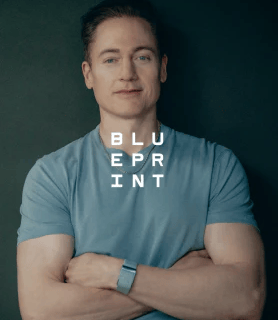Brian Johnson's Blueprint Protocol Is Effective in Slowing Down the Aging Process - Study Results
Supreme.vet
1/5/202511 min read


Brian Johnson's Blueprint Protocol is a comprehensive lifestyle intervention aimed at optimizing health and potentially slowing down the aging process. Developed by entrepreneur Brian Johnson, this protocol incorporates various elements such as nutrition, exercise, sleep management, and cognitive training, promoting a holistic approach to well-being. As the field of biogerontology evolves, the Protocol's emphasis on modifiable lifestyle factors resonates with growing public interest in healthspan—the period of life spent in good health—rather than merely lifespan.[- 1][2][3]
Notably, a recent longitudinal study has evaluated the effectiveness of the Blueprint Protocol, revealing significant insights into its impact on aging among participants. The study employed a mixed-methods design, collecting both quantitative and qualitative data to assess health outcomes across various domains. Key findings indicated that adherence to the Protocol correlated with improved health metrics, suggesting that targeted lifestyle modifications may offer substantial benefits in managing age-related decline.[4][5][6]
Despite the encouraging results, the Blueprint Protocol has sparked debates regarding its accessibility and ethical implications, particularly in relation to socioeconomic factors that may limit its implementation for broader populations. Critics have raised concerns about the feasibility of adhering to such an intensive regimen, as well as the potential for exacerbating health disparities.[7][8][9] These discussions underscore the importance of balancing innovative health interventions with considerations of equity and individual autonomy in healthcare decision-making.
Overall, Johnson's Blueprint Protocol stands out in the landscape of anti-aging initiatives, not only for its scientific grounding but also for its potential to influence future research and practices in health and longevity. The ongoing examination of its efficacy and the ethical considerations surrounding its application will continue to shape the conversation about aging and well-being in contemporary society.[10][11]
Background
Brian Johnson's Blueprint Protocol focuses on a holistic approach to health and longevity, addressing not only the physical but also the psychological, spiritual, and imaginative aspects of well-being. Recent explorations within this framework suggest that social norms can both standardize behavior and restrict individual expression, potentially impacting psychological health and overall wellness[1]. Aging, often perceived as an inevitable process, has garnered attention in the realm of biogerontology, which seeks to explore the complexities of aging and its associated pathologies. Many experts challenge the traditional view of aging as a purely natural occurrence, positing instead that it may be influenced by various modifiable factors, thus opening avenues for intervention[2][3]. This perspective aligns with the growing interest in anti-aging medicine, which aims to promote healthspan—defined as the period of life spent in good health—through dietary and lifestyle modifications, as well as biomedical interventions[3]. The science of longevity has seen rapid advancements, with a notable emphasis on the role of hormones in regulating both physical and mental health as individuals age[4]. These developments have spurred individuals to seek out supplements and lifestyle changes that may help mitigate the effects of aging, thereby enhancing both longevity and quality of life[5]. Brian Johnson's Blueprint Protocol embodies this transformative approach, encouraging participants to explore various facets of their health in pursuit of a longer, healthier life.
The Blueprint Protocol
The Blueprint Protocol, developed by entrepreneur Bryan Johnson, is a comprehensive approach aimed at optimizing human performance and enhancing overall well-being through lifestyle modifications. It integrates various components such as nutrition, exercise, sleep management, and cognitive training to foster a holistic improvement in health.
Core Components
Nutrition
The nutritional aspect of the Blueprint emphasizes a meticulously planned diet, typically consisting of approximately 2,250 calories daily. Key elements include a balanced intake of fats, carbohydrates, and proteins, with specific meals designed to meet these macronutrient goals. For instance, a sample meal plan might include Nutty Pudding, Pea Protein, and Super Veggie dishes, along with healthy fats from sources like extra virgin olive oil and dark chocolate[7][10]. This structured dietary regimen supports long-term health and sustainable eating habits.
Exercise
Exercise within the Blueprint involves a mix of strength training and cardiovascular activities, tailored to be more sustainable for the average person compared to Johnson's rigorous routine. Suggested practices include pull-ups, chin-ups, and high-intensity interval training (HIIT) a few times per week, alongside recreational activities like hiking and sports[10]. This focus on variety aims to make fitness enjoyable and maintainable for individuals at different fitness levels.
Sleep Management
A crucial part of the Blueprint is the emphasis on consistent sleep patterns and optimizing the sleep environment. Johnson adheres to a strict schedule, promoting the importance of sufficient sleep as foundational to achieving optimal health outcomes. His routine includes spending quality time with family before bedtime, illustrating the balance between health and personal well-being[10][12].
Practical Implementation
While Johnson's Blueprint is detailed and intensive, its core principles can be adapted for broader audiences. Individuals are encouraged to utilize accessible technology, such as fitness trackers and health apps, to monitor their health metrics and support their wellness journey. Moreover, adopting basic dietary changes—like reducing processed sugars and embracing a Mediterranean diet—can yield significant health benefits without the need for extensive resources[13].
Study Design
Overview
The study employed a mixed-methods design to evaluate Brian Johnson's Blueprint Protocol, aiming to provide a comprehensive understanding of its efficacy in slowing down the aging process. This design integrated both quantitative and qualitative methodologies, allowing for a robust analysis of the protocol's impact on participants' health and well-being[6][14].
Participants
The cohort consisted of individuals recruited through a rigorous enrollment process, which assessed their suitability for the program based on health and lifestyle criteria. While specific selection criteria were not fully disclosed, the process prioritized participants who demonstrated a strong commitment to adhering to the program's stringent requirements[15]. The study tracked data from these participants over a defined period to observe changes and outcomes related to the protocol.
Data Collection
Data collection methods included a combination of self-reported health parameters and structured assessments. The researchers gathered socio-demographic data, health behaviors, and outcomes through various tools such as surveys and health assessments[6]. Additionally, qualitative interviews were conducted to gain deeper insights into participants' experiences with the Blueprint Protocol, further enriching the data set[14].
Statistical Analysis
The quantitative data analysis involved using established statistical methods to evaluate the effects of the Blueprint Protocol. Discrete outcomes were tabulated, and percentages were calculated. Comparisons between groups utilized Fisher's exact test and t-tests for continuous outcomes. Statistical analyses were conducted using SPSS and Stata software, ensuring robust evaluation of the data collected[6].
Co-Design Approach
A key component of the study's design was the co-design methodology, which involved engaging end-users, including participants and healthcare providers, in the research process. This approach aimed to tailor implementation strategies to meet the specific needs of participants and enhance the relevance of findings to diverse contexts[14][16].
Interdisciplinary Collaboration
To strengthen the credibility of the study findings, an interdisciplinary research group with diverse expertise was involved in the analysis. This collaborative effort facilitated triangulation, allowing for a more nuanced understanding of the data and reinforcing the validity of the conclusions drawn from the study[16].
Results
The results of the Brian Johnson's Blueprint Protocol, aimed at slowing down the aging process, were obtained through a comprehensive longitudinal cohort study involving community-dwelling older adults. Participants contributed self-reported health information through questionnaires administered at baseline (2000/2001), and subsequently at waves 1 (2007/2008), 2 (2009/2010), and additional follow-ups thereafter[6]. The data collected encompassed 18 health-related domains and included pre-clinical markers indicative of functional decline, frailty, and disability.
Key Findings
The study's design, which allowed for repeated measurements over time, facilitated the tracking of individual health trajectories, revealing the complexities of aging among participants. The research underscored that healthy aging is influenced by multiple determinants including genetics, environmental factors, and socio-economic status[16]. Importantly, the cohort demonstrated that a health-promotion intervention within this framework led to favorable outcomes, indicating that ongoing health support could yield beneficial effects on aging processes[17][18]. Furthermore, findings illustrated a significant correlation between the maintenance of functional ability and the socio-environmental context in which participants lived. This highlights the necessity for targeted interventions that address the diverse factors impacting aging individuals' health outcomes[16].
Statistical Analysis
The analysis employed rigorous statistical methods, including Fisher’s exact test for discrete outcomes and t-tests for continuous variables, utilizing SPSS and Stata software to ensure accurate comparisons and interpretations of the data[6].
Participation and Data Collection
From the initial cohort of 3,326 participants, 1,892 individuals responded to all three waves of questionnaires, providing a robust dataset for analysis. Notably, those who remained engaged throughout the study were generally younger and exhibited better health indicators, such as lower incidences of chronic diseases like diabetes and coronary heart disease, compared to those who dropped out[6]. Non-response was primarily attributed to mortality, loss to follow-up, or refusal to continue participation.
Discussion
The implications of the findings surrounding Brian Johnson's Blueprint Protocol in relation to the aging process extend beyond individual health outcomes and touch upon broader ethical considerations in health care for the elderly. As ethical issues are central to discussions of aging, they necessitate a thorough examination of personal beliefs and biases that health care providers hold regarding older adults. For instance, Bennett and Flaherty-Robb (2003) emphasize the importance of acknowledging a prevalent "strong elder bias" in American culture, which can affect the care that older individuals receive and the way their needs are perceived and addressed[11]. This cultural bias may lead to paternalistic attitudes, wherein caregivers assume that older patients require protection rather than autonomy, potentially conflicting with their true wishes and needs.
The Blueprint Protocol, designed to slow down the aging process, raises questions about resource allocation and the ethics of prioritizing certain health interventions for older adults. Young (2003) discusses the tension between public and individual responsibilities in resource distribution, particularly in the context of end-of-life care- [11]. The insights from her work suggest that while protocols like Johnson's aim to improve quality of life, they must also consider the diverse values and wishes of older adults, who may have varying perceptions of successful aging.
Moreover, the research highlights the need for transparency and reflexivity in understanding aging. The interdisciplinary nature of studies on aging, as seen in various research methodologies, allows for a more nuanced perspective that challenges ageist stereotypes[16]. Participants in programs like the high-intensity training (HIT) might initially feel they are being treated differently due to their age, revealing underlying biases about older individuals’ capabilities[16]. Such findings underline the necessity for health care practitioners to engage in ongoing reflection about their own preconceptions and how these may influence their interactions with older patients.
Additionally, the ethical considerations surrounding informed consent and truth-telling are paramount when implementing interventions like the Blueprint Protocol. Conflicts may arise between what health care providers believe older adults should know about their health interventions and what those individuals wish to be informed about. This disconnect can hinder the ethical principle of respect for persons, as outlined in the Code of Ethics for nurses, which calls for valuing the beliefs and wishes of individuals in care provision[11][19]. As health care continues to evolve, particularly with innovative protocols aimed at enhancing longevity and well-being, these ethical discussions will remain critical in ensuring that the rights and preferences of older adults are upheld in practice. Ethical Considerations
The exploration of longevity and anti-aging protocols, such as Brian Johnson's Blueprint Protocol, raises significant ethical considerations that must be addressed within the context of medical practice and research. A foundational element in this discourse is the adherence to ethical guidelines, notably the 1996 Declaration of Helsinki, which emphasizes the importance of informed consent and the welfare of research participants[16]. This framework ensures that individuals are adequately informed about the risks and benefits associated with participation in studies related to aging interventions. In the nursing profession, the American Nurses Association (ANA) Code of Ethics serves as a guiding document for ethical practices when dealing with older populations. It underscores the necessity of respecting individual beliefs and wishes, especially when addressing complex issues such as frailty and the need for protection in elderly patients[11]. This principle can sometimes conflict with the autonomy of older adults, particularly when health care providers must navigate the delicate balance between safeguarding vulnerable patients and allowing them to make informed choices about their own care. Furthermore, the potential financial implications of longevity protocols, such as the Blueprint Diet, pose ethical dilemmas. The high cost associated with specific dietary requirements, supplements, and meal preparations can create barriers to access for many individuals, raising questions about equity and fairness in health care[8]. It is crucial to consider how socioeconomic factors may limit the effectiveness and accessibility of such interventions across diverse populations. Additionally, the implementation of health-promoting strategies must be approached with caution to avoid overgeneralizing findings from experimental studies. For instance, while some studies suggest that dietary restrictions can extend lifespan and delay the onset of age-related diseases in animal models, these results may not directly translate to human populations[3]. Thus, ethical research practices necessitate a careful examination of how findings are communicated to the public and the potential consequences of promoting such interventions without comprehensive evidence of their effectiveness in humans. Finally, the discourse surrounding longevity must also involve a thorough understanding of the societal implications of an aging population. As the global demographic shifts toward a higher proportion of older adults, ethical considerations surrounding resource allocation, public health policies, and the provision of care for chronic age-associated conditions become increasingly critical[4]. Engaging with these eth- ical challenges is essential for the responsible advancement of longevity research and its integration into health care practice.
Emerging Research and Trends
Advances in Longevity Research
Recent advancements in the field of longevity research have shifted the focus from merely extending lifespan to enhancing healthspan, the period during which individuals remain healthy and free from chronic diseases. This transformation is largely attributed to a better understanding of the biological processes that drive aging and the potential to influence them. Research initiatives, such as those undertaken by the Potocsnak Longevity Institute at Northwestern University, aim to explore the relationship between chronological and biological age across various organ systems. These studies are designed to validate interventions that may effectively slow or even reverse the aging process, providing insights into extending healthspan for individuals at risk of accelerated aging due to chronic conditions or environmental factors[2][9].
Multi-Faceted Approaches to Aging
The scientific community is increasingly recognizing that aging is a primary risk factor for numerous diseases, including diabetes, heart disease, and neurodegenerative conditions[2]. As such, there is a growing interest in developing comprehensive approaches that target multiple molecular pathways associated with aging. Experimental studies suggest that dietary restrictions and other interventions can extend lifespan while also delaying the onset of age-related chronic diseases[3]. Furthermore, ongoing discussions about the classification of aging as a clinical condition have led to a more lenient stance from regulatory bodies, encouraging research into substances with anti-aging properties that were previously overlooked[3][4].
Collaborative Efforts in Research
International collaborations have been pivotal in advancing research on aging and longevity. The AARC2 project exemplifies this by providing a blueprint and guidelines that facilitate collaboration among scientists worldwide. By offering training programs and consulting services, the project promotes the adoption of innovative e-infrastructures that support collaborative research efforts across various disciplines[20]. Such initiatives not only enable researchers to focus on their scientific inquiries but also foster a community dedicated to exploring the complexities of aging.
The Role of Hormones in Aging
Hormonal regulation is emerging as a critical area of study in the field of aging. Hormones are vital biochemical messengers that influence numerous aspects of health, including metabolism and cognitive function. Ongoing research aims to uncover how hormonal changes throughout life affect aging and overall health. As scientists continue to explore these relationships, they hope to identify therapeutic strategies that can mitigate the effects of aging and enhance the quality of life in older adults[4].
References
[1]: Monthly Notes — blueprint - Bryan Johnson
[2]: Human Longevity Lab Will Study Methods to Slow or Reverse Aging
[3]: Implementation of longevity-promoting supplements and medications in ...
[4]: The Hormonal Blueprint For Longevity And The Science Of ... - Forbes
[5]: What's Bryan Johnson's Project Blueprint? Does It Stand Up To ... - NOVOS
[6]: Protocol: Bryan Johnson's Blueprint - Knowledge Revolution
[7]: Bryan Johnson’s Blueprint & supplements simplified - AVEA
[8]: Bryan Johnson, Anti-Aging Tech Millionaire, Says He's Not 'Dracula'
[9]: Personal health revolution: How Bryan Johnson's Blueprint could change ...
[10]: The longitudinal urban cohort ageing study (LUCAS): study protocol and ...
[11]: Co-designing a blueprint for spreading person-centered, Whole Health ...
[12]: Bryan Johnson’s Project Blueprint: Revolutionary science or expensive fad?
[13]: Negotiating a physically active life in tune with ageing: a grounded ...
[14]: Current Results | Diet & Supplements — blueprint - Bryan Johnson
[15]: Appendix — blueprint - Bryan Johnson
[16]: Ethics: Ethical Challenges in the Care of Elderly Persons
[17]: Blueprint Ingredients Review – Blueprint Bryan Johnson
[18]: The Bryan Johnson Blueprint Diet: A Detailed Breakdown – Nutriphy
[19]: At the Human Longevity Lab, studying methods to slow or reverse aging ...
[20]: A blueprint for accelerating research collaborations






